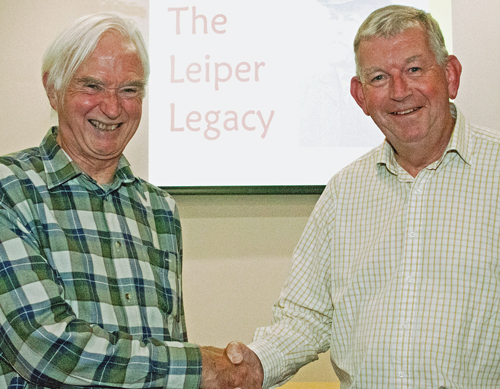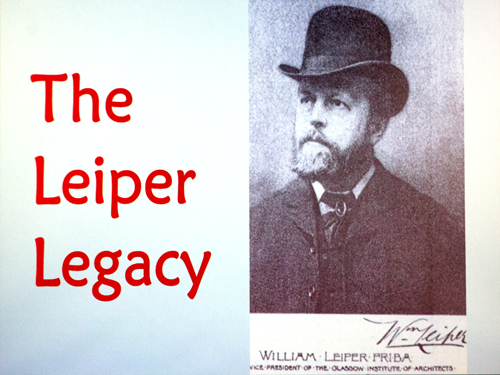AN ICONIC figure of Helensburgh’s past was the topic at Helensburgh Heritage Trust’s first ever meeting at the former Clyde Street School on Wednesday September 28 2016.
The Trust began the new session of 2016-17 winter open meetings in the Marriage Room at the new Helensburgh and District Civic Centre, with some sixty members and guests attending.
 The speaker was Ewan Kennedy, who travelled from his home in Oban to talk about architect William Leiper, who lived in the burgh, designed the Victoria Infirmary and many mansions, and also made additions and alterations to other homes.
The speaker was Ewan Kennedy, who travelled from his home in Oban to talk about architect William Leiper, who lived in the burgh, designed the Victoria Infirmary and many mansions, and also made additions and alterations to other homes.
Ewan, a retired lawyer who runs the Leiper Gallery in the Leiper-designed Sun Insurance building at 117 West George Street, Glasgow, ran an exhibition to mark the centenary of Leiper’s death from May 27, the actual anniversary, until August 28.
It was entitled ‘Introduction to the Electric City’, and was part of the Festival of Architecture 2016.
“Leiper’s legacy can be seen by just walking around Helensburgh,” he said.
“He was quite an outgoing person. He never married, but had a wide circle of friends and a busy social life.”
William Leiper, who lived in the town from after his father’s death in 1869 until his own death in 1916, was born in Glasgow on May 21 1839, the son of William Leiper and his wife Jane Mellis, and was an only child.
His father ran a private school in George Street and was descended from 17th century Aberdeenshire master masons of that name, and his mother was Isabella, nee Myles.
Educated by his father and at Glasgow High School, he served his apprenticeship with Boucher & Cousland in Glasgow, then went to London for further training, working for John Loughborough Pearson who was an ecclesiastical architect involved in promoting the Gothic revival and specialising in French Gothic.
There he came into the circle of Edward William Godwin and William Burges, also part of the lste Victorian Gothic movement, who was later to propose him as a Fellow of the Royal Institute of British Architects.
After a spell in Dublin acting as vlerk of works in the building of Findlater's Church, he returned to Glasgow, and in 1864 formed a partnership with Robert Grieve Melvin which lasted for three years before ending in a dispute which led to Melvin giving up architecture for hotel keeping.
Leiper’s reputation was immediately established in 1864 when he won the competition for Dowanhill Church in Glasgow in 1864, and the design of the church and its hall was much admired.
The following year he designed two iconic Dumbarton buildings, the Academy — now Braehead Primary — and the Burgh Hall, of which only the façade now remains.
In some of his more restrained early houses he adopted the low-pitched roofs and compositional methods of Alexander ‘Greek’ Thomson, a friend in his early years, a good example of which is Rhu-Arden in Upper Sutherland Crescent.
It is next door to Terpersie, Leiper’s own home, which he built for himself in 1871 and named Thurloe, and which makes good use of sculpture which he liked to use in many of his designs.
By 1869 he had developed his own rather French version of Scottish baronial architecture with sculptured towers and turrets, often working with stained glass expert Daniel Cottier.
The boarded-up Cairndhu on the seafront — at one time the home of the first Baron Strathclyde, Alexander Ure, and later an hotel and nursing home — was designed in 1871 for Glasgow Lord Provost John Ure and had lavish Anglo-Japanese interiors of which a gold ceiling survives. Cottier again supplied stained glass for the mansion.
His later houses became progressively more arts-and-crafts with an occasional American influence, as at Morar, formerly Drumadoon, across Upper Colquhoun Street from Charles Rennie Macintosh’s Hill House, now empty and deteriorating but which may be restored soon.
 He worked on various churches in Helensburgh, Glasgow and Kilmacolm, and he designed the interior of the Czar of Russia’s yacht Livadia in 1880. The following year he was admitted as an FRIBA.
He worked on various churches in Helensburgh, Glasgow and Kilmacolm, and he designed the interior of the Czar of Russia’s yacht Livadia in 1880. The following year he was admitted as an FRIBA.
His commercial commissions were few but stunning.
In 1889, as an architectural advertisement for their carpets, he built the red stone, brick and tile Templeton Factory on Glasgow Green, and in 1893-94 the huge Sun Insurance Building on Glasgow’s West George Street — which won him a Silver Medal at the Paris Exhibition of 1900.
From his earliest days Leiper was a skilful watercolourist and experimented with photography.
None of his paintings is in a public collection, but his many artist friends, which included William McTaggart for whom he was best man, brought him the commission to supervise the scheme of murals by the Glasgow Boys in the Banqueting Hall of Glasgow’s City Chambers.
He specialised in landscapes which sold very well, and he was elected as an associate of the Royal Scottish Academy in 1891 and full member in 1896. From 1870 onwards he exhibited works in watercolour and oil.
A very wealthy man, he served as a Justice of the Peace, was an officebearer of St Columba Church and superintendent of its Sunday School, and was a member of several local organisations connected with the arts. He was also a keen rose grower.
After a long illness which resulted from serious blood poisoning when he stood on a rusty nail at a building site in 1903, he had to retire completely in 1909, by which time he had been recognised as one of Scotland’s leading architects of the period.
He died peacefully of a cardiac haemorrhage at Terpersie at the age of 77.
The obituary in the Helensburgh and Gareloch Times began: “In the sudden passing of Mr William Leiper, Helensburgh has lost one of its most cultured and artistic residents and a gentleman greatly esteemed and beloved by all classes of the community.
"Of a genial, winsome personality and unobtrusive disposition, it was not surprising that he should make and keep so many friends, who will always lovingly cherish his memory."
Mr Kennedy was introduced by Trust chairman the Rev David Clark, who also proposed the vote of thanks.





